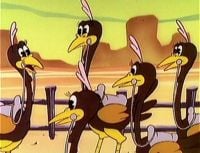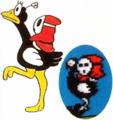Ostro
- This article is about Ostro, the ostrich creature in Super Mario Bros. 2. For the boss character mistakenly labeled as "Ostro" in the Super Mario Bros. 2 cast roll, see Birdo.
Template:Species-infobox Ostros are large, flightless birds that first appeared in Super Mario Bros. 2, and are said to be a mode of transportation in Subcon.[1] They are the first species that allow Mario to ride them, even though they are enemies. In the cast roll of Super Mario Bros. 2, Ostros' and Birdo's names were switched, causing some confusion; this mistake was fixed in Super Mario Advance.
History
Super Mario Bros. 2
Ostros made their debut in Super Mario Bros. 2, where they were ridden by red Shyguys that try to steer them towards the player. If their rider was dislodged the Ostro will travel in a straight line. Players can jump on top of an Ostro and ride it across obstacles regardless of whether or not it already has a Shyguy rider. Ostros can be picked up with very little effort, but they do not bounce when thrown. In Super Mario Advance, they drop hearts when defeated.
While Ostros are black with white wings and legs and red eyes in the NES version of the game, subsequent remakes have depicted them as being pink with a white belly, wings that are the same color as their body, orange legs, black eyes and a pink feather on their heads. The original artwork's attributes are mostly true to the original sprites, those they have yellow beaks and legs, as well as a white tuft on their heads. The artwork for the Japanese release of Super Mario USA lacks the feather on the head the original artwork had, and depicts it as having three toes on each foot, unlike the original artwork and real ostriches, which have two. This artwork was retouched for Super Mario Advance, coloring it pink, but retaining the lack of feather and white wings.
The Super Mario Bros. Super Show!
Several Ostros, though usually referred to as ostriches, appear in several episodes of The Super Mario Bros. Super Show!, where they are usually ridden and used to haul motorless vehicles, much like horses. Due to their role, Ostros never have any speaking lines, and usually make honking noises. They first appear in the episode "Butch Mario & The Luigi Kid", where several Ostros are used by Mario, Luigi, Snifits and several other characters as steeds to travel through the Wild West. A wild ostrich appears in "Too Hot to Handle" on the island of Waki-Waki. Mario, Luigi, and Toad ride it to reach Princess Toadstool faster. Like in the game, they are black, but can also be a dark brown color. Additionally, their wings are orange, have pink feathers on their head, and possess a purple saddle, and bridle.
List of episodes featuring Ostros
- Butch Mario & The Luigi Kid
- Love 'Em and Leave 'Em
- Brooklyn Bound
- The Fire of Hercufleas
- Too Hot to Handle
- The Unzappables
- The Mark of Zero
- The Ten Koopmandments
- The Great Gold Coin Rush
- The Provolone Ranger
Super Mario Bros. movie
Ostros were also given homage in the Super Mario Bros. film, which featured a sign with the word "Ostro" on it.
Gallery
Names in other languages
| Language | Name | Meaning |
|---|---|---|
| Japanese | ダウチョ[2] Daucho |
From 「鴕鳥」(dachō, meaning ostrich) |
| Chinese | 鸵鸵鸟[3] Tuótuó Niǎo |
Ostrich |
| French | Autruche |
Ostrich |
| German | Ostro |
- |
| Italian | Strutzo (Super Mario Advance's booklet) |
From struzzo (ostrich). Coincidentally, the plural form of "Strutzo" is "Strutzi", the Italian name of Birdo. |
| Spanish | Avestruz |
Ostrich |
| Swedish | Strutso |
Ostricho |
References
- ^ "He serves as a means of transportation in the world of dreams. Shyguys often ride him." - Super Mario Bros. 2 instruction booklet, page 26 (Ostro description).
- ^ Yume Kōjō: Doki Doki Panic instruction booklet, page 34.
- ^ From the ending scenes of Super Mario Advance as localized by iQue. Source: 无敌阿尔宙斯 (August 28, 2013). 神游 超级马力欧2敌人官译 (Official names for iQue Super Mario 2 enemies). Baidu Tieba. Retrieved February 2, 2017.


